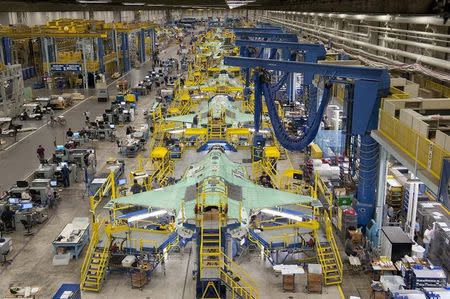Exclusive: Lockheed, suppliers brainstorm how to lower F-35 operating costs

By Andrea Shalal WASHINGTON (Reuters) - Lockheed Martin Corp met with 90 key suppliers last week to brainstorm ways to lower the long-term cost of operating and maintaining the F-35 fighter jets from the Pentagon's current forecast of $1.02 trillion through 2065. Top officials from the Pentagon's Defense Contracts Management Agency and the Defense Contracts Audit Agency were also on hand during two days of talks in Fort Worth, Texas. Tom Owen, vice president of F-35 sustainment strategies for Lockheed, told Reuters the meeting was "an initial, early step" toward mapping out specific measures to cut the plane's hefty sustainment costs. "We are laser-focused on identifying the cost drivers for the F-35 air system and what we can do to reduce those costs as much as possible," Owen said, noting that industry-government relations were more collaborative than in past years. "It's in everybody's interest to make this aircraft more affordable to build and more affordable to sustain," he said. The trillion-dollar so-called "sustainment" price tag for the Joint Strike Fighter, the Pentagon's costliest weapons program, comes on top of the $399 billion projected cost of developing and buying 2,457 jets for the U.S. military in coming decades. Lockheed, the prime contractor on the program, and key suppliers Northrop Grumman Corp and Britain's BAE Systems last month said they would spend $170million over two years to reduce the cost of producing the warplanes to under $80 million each by 2019. But the longer-term cost of flying and servicing the planes continues to vex the Pentagon, the contractors, and engine maker Pratt & Whitney, a unit of United Technologies Corp, which has a separate contract with the government for the F135 engines that power the new warplane. Owen said suppliers at the meeting heard "encouraging words" from U.S. Air Force Lieutenant General Chris Bogdan and other government officials about the program, despite an engine failure that grounded the fleet for over three weeks this summer. One idea discussed in Fort Worth was the use of multiple-year contracts, and eventual adoption of performance-based logistics contracts, under which the supplier would be responsible for maintaining weapons and ensuring certain reliability levels, rather than paying for item-by-item repairs. Such deals give incentives to suppliers to drive costs down even further, Owen said. Multi-year contracts would make it easier for suppliers to invest in process and hardware improvements, he said. Owen said Lockheed hoped to gradually shift into such arrangements with the government and its suppliers in coming years, but would need approval from Congress and the Pentagon. F-35 program officials also met with representatives from the Pentagon's Defense Contracts Management Agency and the Defense Contracts Audit Agency, said Joe DellaVedova, a spokesman for the F-35 program office. It was critical for the program to create "the right framework" to help drive costs lower, he said. Mark Buongiorno, who heads Pratt's domestic and after market business development, said production and sustainment of theF135 engine were closely integrated since original and replacement parts could be ordered together. "We have one supply chain and that allows us to leverage the overall volume, which benefits the 'war on cost' and drives down the price," Buongiorno said. He said Pratt was also in talks with the Pentagon about a performance-based logistics system, which could help lower costs across the board. (Reporting by Andrea Shalal, editing by Ros Krasny and Gunna Dickson)

